Abstract
Cross entropy, a measurement of the complexity/predictability of a series of observations given a probabilistic model, has been used in a variety of domains in music scholarship for decades. This paper presents a novel application of this metric to musical corpus analysis. Given a series of divisions to a larger corpus, a sub-corpus is relatively “unique” if a probabilistic model derived from its pieces better predicts its constituent pieces than do models derived from other sub-corpora. A sub-corpus is relatively “coherent” if its own model describes its pieces better than a model derived from the entire corpus. The Yale-Classical-Archives corpus was used to illustrate several strategies for sub-corpus division, each of which are tested for uniqueness and coherence. Some broader interpretive applications are also described.
Access this chapter
Tax calculation will be finalised at checkout
Purchases are for personal use only
Similar content being viewed by others
References
Shannon, C.E.: A mathematical theory of communication. Bell Syst. Techn. J. 27, 379–423, 623–656 (1948)
Shannon, C.E., Weaver, W.: A Mathematical Model of Communication. University of Illinois Press, Urbana (1949)
Meyer, L.: Meaning in music and information theory. J. Aesthetics Art Criticism 15(4), 412–424 (1957)
Cohen, J.E.: Information theory and music. Behav. Sci. 7(2), 137–163 (1962)
Youngblood, J.E.: Style as information. J. Music Theor. 2, 24–35 (1958)
Mendel, A.: Some preliminary attempts at computer-assisted style analysis in music. Comput. Humanit. 4(1), 41–52 (1969)
Duane, B.: Agency and information content in eighteenth- and early nineteenth-century string-quartet expositions. J. Music Theor. 56(1), 87–120 (2012)
Temperley, D.: Music and Probability. The MIT Press, Cambridge (2007)
White, C., Quinn, I.: The yale-classical archives corpus. Empirical Musicology Rev. 11(1), 50–58 (2016)
Quinn, I.: What’s ‘Key for Key’: A Theoretically Naive Key–Finding Model for Bach Chorales. Zeitschrift der Gesellschaft für Musiktheorie 7 (2010)
Quinn, I., Mavromatis, P.: Voice-leading prototypes and harmonic function in two chorale corpora. In: Agon, C., Andreatta, M., Assayag, G., Amiot, E., Bresson, J., Mandereau, J. (eds.) MCM 2011. LNCS, vol. 6726, pp. 230–240. Springer, Heidelberg (2011). https://doi.org/10.1007/978-3-642-21590-2_18
White, C.W.: An alphabet-reduction algorithm for chordal n-Grams. In: Yust, J., Wild, J., Burgoyne, J.A. (eds.) MCM 2013. LNCS, vol. 7937, pp. 201–212. Springer, Heidelberg (2013). https://doi.org/10.1007/978-3-642-39357-0_16
Cuthbert, M.S., Ariza, C.: music21: a toolkit for computer–aided musicology and symbolic music data. In: Proceedings of the International Symposium on Music Information Retrieval, pp. 637–42 (2011)
White, C.: Changing styles, changing corpora, changing tonal models. Music Percept. 31(2), 244–253 (2014)
Author information
Authors and Affiliations
Corresponding author
Editor information
Editors and Affiliations
Rights and permissions
Copyright information
© 2017 Springer International Publishing AG
About this paper
Cite this paper
White, C.W. (2017). Cross Entropy as a Measure of Coherence and Uniqueness. In: Agustín-Aquino, O., Lluis-Puebla, E., Montiel, M. (eds) Mathematics and Computation in Music. MCM 2017. Lecture Notes in Computer Science(), vol 10527. Springer, Cham. https://doi.org/10.1007/978-3-319-71827-9_25
Download citation
DOI: https://doi.org/10.1007/978-3-319-71827-9_25
Published:
Publisher Name: Springer, Cham
Print ISBN: 978-3-319-71826-2
Online ISBN: 978-3-319-71827-9
eBook Packages: Computer ScienceComputer Science (R0)




